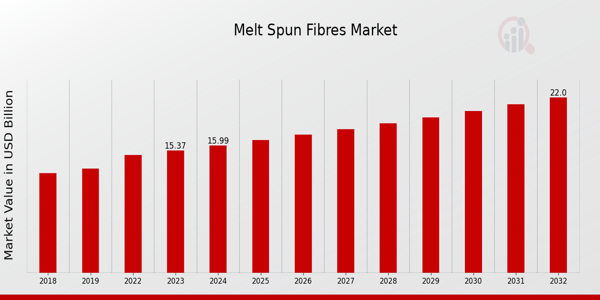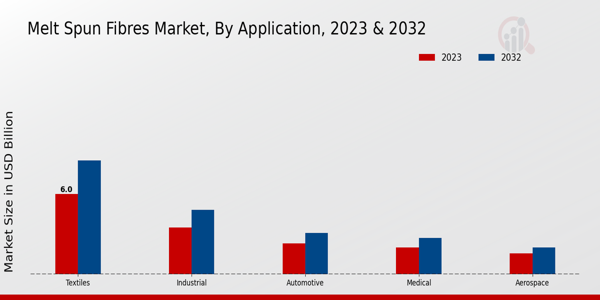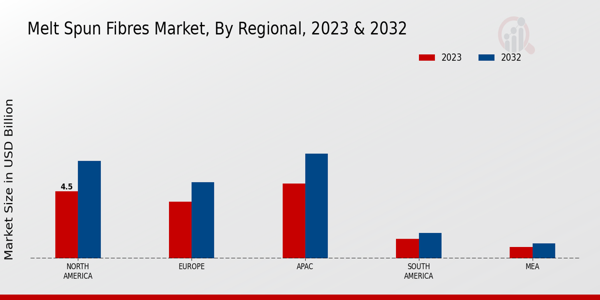Global Melt Spun Fibres Market Overview
The Melt Spun Fibres Market Size was estimated at 16.65 (USD Billion) in 2024. The Melt Spun Fibres Market is expected to grow from 17.33 (USD Billion) in 2025 to 24.82 (USD Billion) by 2034. The Melt Spun Fibres Market CAGR (growth rate) is expected to be around 4.1% during the forecast period (2025 - 2034).
Key Melt Spun Fibres Market Trends Highlighted
The Melt Spun Fibres Market is witnessing significant expansion, primarily fueled by the growing demand for high-performance textiles across diverse sectors, including apparel, automotive, and home furnishings.
Key factors propelling this market include an increasing awareness of sustainable and eco-friendly materials, which has encouraged manufacturers to innovate and create melt-spun fibers that are not only robust but also environmentally sustainable.
The comfort, durability, and versatility of these fibers are crucial in promoting their use in both consumer and industrial applications. There exist considerable opportunities for product development, especially in the realm of functional textiles that provide moisture-wicking capabilities, UV protection, and improved breathability.
The growing trend of athleisure wear has also opened new avenues for the application of melt-spun fibers, allowing for a blend of style and functionality. Additionally, advancements in technology can lead to improved production processes, enhancing the efficiency and scalability of melt-spun fiber manufacturing, which can attract more investments in this segment.
Recent trends indicate a shift towards the use of recycled materials and a focus on circular economy principles within the melt-spun fibers sector. This aligns with sustainability initiatives and consumer preferences for responsible sourcing.
The industry is witnessing a surge in collaborations and partnerships between textile manufacturers and technology firms aimed at developing innovative solutions.
The continued integration of smart textiles, which incorporate sensor technology and other advancements, is expected to further transform the landscape of melt spun fibres, paving the way for new applications and market expansion.
With the growing focus on sustainability and performance, the outlook for the Melt Spun Fibres Market appears promising, driven by innovation and consumer demand.

Source: Primary Research, Secondary Research, MRFR Database and Analyst Review
Melt Spun Fibres Market Drivers
Increasing Demand for Sustainable Materials
The trend towards sustainability is one of the most significant drivers for the Melt Spun Fibres Market. As awareness about environmental issues continues to grow, consumers, manufacturers, and brands are increasingly seeking materials that have a lower ecological footprint.
Melt-spun fibers, which are produced using less energy and less water compared to traditional textile manufacturing processes, are becoming increasingly popular as a choice for sustainable production.
Innovations in melt-spinning technology have allowed for the development of biodegradable and recyclable fibers, which not only reduce waste but also appeal to consumers who prioritize eco-friendly products.
With governments and organizations around the world promoting sustainable practices, the demand for melt-spun fibers is expected to increase significantly in the coming years.
Furthermore, industries such as fashion and home textiles are actively adopting these sustainable materials, leading to enhanced growth opportunities within the Melt Spun Fibres Market.
The continuing shift in consumer preferences towards eco-conscious products is expected to drive innovations and adaptations in melt-spinning technologies, further boosting the market.
As brands commit to sustainability and enhance transparency in their supply chains, the use of melt spun fibres will likely become a standard, thereby positioning the Melt Spun Fibres Market for substantial growth in the future.
Technological Advancements in Production Processes
Advancements in manufacturing technologies are playing a crucial role in driving the growth of the Melt Spun Fibres Market. The development of new and innovative melt-spinning techniques has improved the efficiency, quality, and performance of melt-spun fibers.
Automation and digitization in production processes have reduced costs and increased output, allowing manufacturers to meet the rising demand efficiently. These technological innovations ensure that the production of melt-spun fibers not only meets quality standards but also adheres to sustainability goals.
As production becomes more efficient, manufacturers can offer competitive pricing, further driving market growth.
Growing Applications Across Multiple Industries
The versatility of melt-spun fibers is driving their adoption in various sectors, including textiles, automotive, and medical applications.
As industries recognize the benefits of melt-spun fibers, including their lightweight nature, durability, and moisture-wicking properties, the demand for these materials is expected to rise significantly.
The expansion of application areas translates into new opportunities and market segments for the Melt Spun Fibres Market.
Melt Spun Fibres Market Segment Insights
Melt Spun Fibres Market Application Insights
The Melt Spun Fibres Market is notably driven by its diverse applications across various industries. The Application segment played a crucial role in the market's growth trajectory, encompassing the crucial sectors of Textiles, Industrial, Automotive, Medical, and Aerospace.
The Textiles sector stood significant, representing a valuation of 6.0 USD Billion in 2023, and is poised to reach 8.5 USD Billion by 2032, showcasing its dominance as a major contributor to the market, largely due to the increasing demand for comfortable and durable fabrics in fashion and home textiles.
The Industrial application, valued at 3.5 USD Billion in 2023, signified the notable growth opportunities in this area, as Melt Spun Fibres became essential for manufacturing a variety of products, including filters and insulation materials, enabling efficiency and sustainability.
Furthermore, the Automotive sector, valued at 2.3 USD Billion in 2023, underscored the significance of Melt Spun Fibres in the production of lightweight and high-strength materials that facilitated improved fuel efficiency and vehicle performance.
The Medical application, valued at 2.0 USD Billion in 2023, highlighted the importance of advanced materials utilized in surgical and protective garments, reflecting a critical growth area as healthcare continues to evolve.
Finally, the Aerospace application, while relatively smaller with a valuation of 1.57 USD Billion, demonstrated significant growth potential due to the increasing adoption of lightweight materials that enhance aircraft performance and reduce operational costs.
These insights into the Application segment revealed the interrelated growth drivers and trends within the Melt Spun Fibres Market, with each sector demonstrating unique needs that contribute to the overall market dynamics and future opportunities.
Overall, the combination of technological advancements and material innovations continues to fuel the expansion and segmentation of the market, solidifying its importance across multiple industries.

Source: Primary Research, Secondary Research, MRFR Database and Analyst Review
Melt Spun Fibres Market Type Insights
The Melt Spun Fibres Market exhibits a variety of types that contribute to its growth and complexity. This market includes several fibers, such as Polyester, Nylon, Polypropylene, Polyethylene, and others, each playing a crucial role in catering to diverse application needs.
Polyester, known for its strength and versatility, continues to dominate due to its wide use in textiles and industrial applications, while Nylon is favored for its durability and elasticity, making it popular in fashion and sportswear.
Polypropylene, recognized for its lightweight and chemical resistance, is increasingly utilized in packaging and automotive sectors. The significance of Polyethylene lies in its cost-effectiveness and adaptability, finding applications across various industries, as well as in non-woven products.
The variety in type ensures that the Melt Spun Fibres Market segmentation remains robust, with each type experiencing varying levels of demand driven by specific industry requirements.
As the industry evolves, growth drivers include technological advancements and increasing applications, although challenges like recycling and environmental considerations must also be addressed.
In analyzing Melt Spun Fibres Market data, it becomes evident that the robust performance and adaptability of these fibers continue to shape market dynamics effectively.
Melt Spun Fibres Market End Use Industry Insights
The Melt Spun Fibres Market is notably influenced by the End Use Industry, which encompasses several key sectors such as Fashion, Consumer Goods, Construction, Healthcare, and Transportation.
The Fashion industry represents a substantial portion of this market, as consumers increasingly seek lightweight, durable fabrics for apparel. Similarly, the Consumer Goods sector is leveraging melt-spun fibers for various products, thanks to their ability to provide enhanced strength and versatility.
Construction also benefits from these fibers, which contribute to the production of durable materials important for infrastructure. In the Healthcare sector, melt-spun fibers play a vital role in producing surgical garments and medical textiles, driven by the demand for hygienic and high-performance materials.
Lastly, the Transportation segment utilizes these fibers due to their lightweight characteristics, leading to improved fuel efficiency in automotive and aerospace applications. Overall, the trends in sustainability and innovation are anticipated to drive further growth across these segments, making the Melt Spun Fibres Market a dynamic and evolving landscape.
Melt Spun Fibres Market Form Insights
The Melt Spun Fibres Market is witnessing steady growth driven by various factors, including the rising demand for versatile fibers across multiple industries. The Form segment within this market comprises a diverse range of products, including Staple Fiber, Filament Fiber, Microfiber, and Continuous Fiber, each playing a critical role in the market dynamics.
Staple Fiber is favored for its use in textiles, largely due to its availability and ease of processing, while Filament Fiber is preferred in applications requiring strength and durability.
Microfiber has gained traction due to its softness and water-repellent properties, making it suitable for high-performance materials, thus appealing to the apparel and hygiene markets.
Continuous Fiber dominates in industrial applications where consistent length and tensile strength are essential. These segments collectively contribute to the evolving Melt Spun Fibres Market landscape, highlighting opportunities for innovation while catering to the growing consumer preferences for sustainable and high-quality products.
Melt Spun Fibres Market Regional Insights
North America held a majority holding with a valuation of 4.5 USD Billion in 2023, reflecting its robust industrial applications and increasing demand for advanced fiber technologies. Following closely was the APAC region, valued at 5.0 USD Billion, driven by rapid urbanization and a growing textile industry, indicating its significance in the market.
Europe, valued at 3.8 USD Billion, also served as a major player, primarily due to innovations in sustainable materials that cater to environmental concerns.
South America and MEA, meanwhile, showed smaller market values of 1.3 USD Billion and 0.77 USD Billion, respectively, in 2023, yet these regions present growth opportunities through expanding manufacturing capabilities and textile production.
As consumers increasingly prioritize performance and sustainability, the Melt Spun Fibres Market data indicate a trend toward advanced fiber solutions, positioning these regions uniquely in addressing market growth and evolving consumer preferences.

Source: Primary Research, Secondary Research, MRFR Database and Analyst Review
Melt Spun Fibres Market Key Players and Competitive Insights
The Melt Spun Fibres Market is characterized by a dynamic competitive landscape where several key players vie for market share through strategic advancements in technology, innovation in product offerings, and the exploration of new applications and markets.
As demand for melt-spun fibers continues to rise due to their versatile properties and wide range of applications in textiles, automotive, and medical sectors, companies are increasingly focusing on developing advanced materials that offer enhanced performance and sustainability features.
Companies in this market are also enhancing their production capabilities and optimizing supply chains to meet the growing needs of end-users while effectively managing costs.
The competitive dynamics encompass not only product differentiation and pricing strategies but also collaborations and partnerships aimed at expanding geographic reach and enhancing research and development efforts.
Asahi Kasei has established a strong position in the Melt Spun Fibres Market through its robust product portfolio and innovative approach. Known for its commitment to quality and technological advancement, Asahi Kasei benefits from a comprehensive understanding of market demands and consumer preferences.
The company emphasizes sustainability and has integrated environmentally friendly practices into its manufacturing processes, which enhances its reputation and appeal among eco-conscious consumers.
This forward-thinking attitude enables Asahi Kasei to penetrate various sectors effectively, providing solutions that meet evolving market specifications while maintaining high standards of performance.
Furthermore, their continuous investment in research and development fosters an environment of innovation, allowing them to stay at the forefront of the industry and respond swiftly to emerging trends.
Mitsubishi Chemical is a formidable player in the Melt Spun Fibres Market, recognized for its technical expertise and extensive market knowledge. The company leverages its experience to deliver high-quality melt-spun fibers that are tailored to meet the specific requirements of diverse applications across several industries.
Mitsubishi Chemical emphasizes innovation, consistently working to enhance the formulation and processing techniques of its products to improve performance characteristics such as strength, durability, and comfort.
Additionally, the company actively focuses on sustainability, incorporating eco-friendly materials and processes in their production lines.
This dedication to innovation and environmental responsibility positions Mitsubishi Chemical as a trusted supplier within the market, enabling strong partnerships with clients and a solid reputation for reliability and excellence in product offerings.
Key Companies in the Melt Spun Fibres Market Include
- Asahi Kasei
- Mitsubishi Chemical
- Solvay
- Huntsman
- Covestro
- SABIC
- Celanese Corporation
- FibreVisions
- Teijin Limited
- BASF
- LyondellBasell
- Lanxess
- Toray Industries
- DuPont
- Eastman Chemical
Melt Spun Fibres Market Developments
Recent developments in the Melt Spun Fibres Market have been significant, with Asahi Kasei and Mitsubishi Chemical reporting increased production capacities to meet the growing demand for synthetic fibers in various applications.
Solvay has also invested in innovative melt-spun technologies aimed at enhancing product performance, while Huntsman has expanded its portfolio through strategic partnerships to leverage sustainable practices in fiber production.
Companies like Covestro and SABIC are focusing on eco-friendly materials to align with sustainability trends. Furthermore, recent mergers and acquisitions have reshaped the competitive landscape, notably DuPont's acquisition of a fiber innovations company, reinforcing its position in the market.
BASF and LyondellBasell are also making strides through collaborations to enhance their product offerings in the melt-spun fibers segment. These corporate movements signal growth prospects within the industry as they adapt to evolving consumer preferences and environmental regulations.
The valuation of these companies is notably influenced by their ability to innovate and implement sustainable practices, contributing to market expansion and enhanced competitive advantage in an increasingly environmentally conscious market.
Melt Spun Fibres Market Segmentation Insights
Melt Spun Fibres Market Application Outlook
- Textiles
- Industrial
- Automotive
- Medical
- Aerospace
Melt Spun Fibres Market Type Outlook
- Polyester
- Nylon
- Polypropylene
- Polyethylene
- Others
Melt Spun Fibres Market End Use Industry Outlook
- Fashion
- Consumer Goods
- Construction
- Healthcare
- Transportation
Melt Spun Fibres Market Form Outlook
- Staple Fiber
- Filament Fiber
- Microfiber
- Continuous Fiber
Melt Spun Fibres Market Regional Outlook
- North America
- Europe
- South America
- Asia Pacific
- Middle East and Africa
| Report Attribute/Metric |
Details |
| Market Size 2024 |
16.65 (USD Billion) |
| Market Size 2025 |
17.33 (USD Billion) |
| Market Size 2034 |
24.82 (USD Billion) |
| Compound Annual Growth Rate (CAGR) |
4.1% (2025 - 2034) |
| Report Coverage |
Revenue Forecast, Competitive Landscape, Growth Factors, and Trends |
| Base Year |
2024 |
| Market Forecast Period |
2025 - 2034 |
| Historical Data |
2020 - 2024 |
| Market Forecast Units |
USD Billion |
| Key Companies Profiled |
Asahi Kasei, Mitsubishi Chemical, Solvay, Huntsman, Covestro, SABIC, Celanese Corporation, FibreVisions, Teijin Limited, BASF, LyondellBasell, Lanxess, Toray Industries, DuPont, Eastman Chemical |
| Segments Covered |
Application, Type, End Use Industry, Form, Regional |
| Key Market Opportunities |
Sustainable fiber production techniques, Increased demand in automotive applications, Growth in technical textiles market, Advancements in recycling technologies, Rising demand for eco-friendly materials |
| Key Market Dynamics |
sustainable production methods, increasing demand for innovative textiles, regulatory compliance and safety concerns, advancements in fiber technology, fluctuating raw material prices |
| Countries Covered |
North America, Europe, APAC, South America, MEA |
Frequently Asked Questions (FAQ) :
The projected market size of the Melt Spun Fibres Market in 2034 is expected to reach 24.82 USD Billion.
In 2024, the market size of the Melt Spun Fibres Market was valued at 16.65 USD Billion.
The expected CAGR for the Melt Spun Fibres Market from 2025 to 2034 is 4.1%.
North America is expected to dominate the Melt Spun Fibres Market in 2034 with a value of 6.5 USD Billion.
The textile application of the Melt Spun Fibres Market generated revenue of 6.0 USD Billion in 2024.
The market size for the Industrial application in the Melt Spun Fibres Market is projected to be 4.8 USD Billion in 2034.
Key players in the Melt Spun Fibres Market include Asahi Kasei, Mitsubishi Chemical, Solvay, Huntsman, and Covestro.
The projected market size for the Automotive application in the Melt Spun Fibres Market is anticipated to be 3.1 USD Billion in 2034.
The expected value of the Aerospace application in the Melt Spun Fibres Market for 2024 was 1.57 USD Billion.
The Melt Spun Fibres Market in South America is expected to grow from 1.3 USD Billion in 2025 to 1.7 USD Billion in 2034.

















